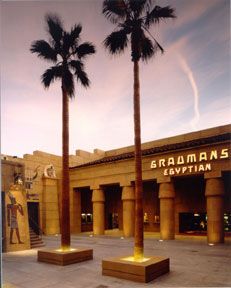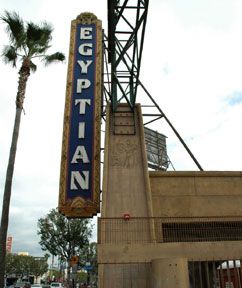Karin Sabin
Staff Writer
Pharaohs. Mummies. Pyramids. Brad Pitt. What do all these elements have in common? If you want to see Pitt’s latest movie, and actually meet Brad himself, head to one of the most star-studded picture palaces in America, the Egyptian Theatre.
 Photo Courtesy Tom Bonner
Photo Courtesy Tom Bonner
The non-profit Egyptian Theatre at 6712 Hollywood Blvd. is hailed as an architectural landmark, and is a major attraction among the estimated 9 million tourists who visit Hollywood Boulevard each year.
But it’s not strictly about celebrities. The theater showcases classic films, documentaries, independent films, world cinema and new releases to celebrate and preserve film. The Egyptian features live discussion with filmmakers and actors from the movies being screened.
Audience members can attend a double-feature with the actor’s new release followed by the screening of a previous film in the actor’s repertoire.
On Jan. 7, John Travolta discussed his film and his career between the double feature of his latest, “A Love Song for Bobby Long,” and one of his most critically acclaimed films, “A Civil Action.”
“The Egyptian makes the film have a personal appeal because it cares about the filmmaking process,” said senior Bri Dellinger, a telecommunication production major with an emphasis in film. “It’s about seeing someone who made it, instead of being strictly about entertainment value.”
The theater reopened in December 1998 after a $15-million renovation by American Cinematheque. Preserved inside the historic shell is the 616-seat Lloyd E. Rigler Theater and the 78-seat Steven Spielberg Theater.
 Ben Young/Photo Editor
Ben Young/Photo Editor
The renovation is aimed at preserving historic aspects, like the original Egyptian-motif sunburst ceiling, while also incorporating modern aspects like state-of-the-art technology and acoustics.
New installments complement the antique feel, like the 1922 Wurlitzer organ installed for silent-film presentations. The Egyptian’s renovation won the 2000 National Preservation Honor Award, presented by the National Trust for Historic Preservation.
Designed by architects Meyer and Holler, the Egyptian was built by Sid Grauman in 1922. The discovery of King Tut’s tomb that same year inspired the Egyptian theme. The architecture features massive Egyptian-style columns, hieroglyphics, murals, tiled fountains, exotic plants and a gigantic Egyptian-god statue that guards the balcony.
The Egyptian theater served as the birthplace of the glitz and glam that is now an inherent part of Hollywood. In fact, the very first Hollywood movie premiere, “Robin Hood,” starring Douglas Fairbanks, was held there Oct. 18, 1922. It served as the model for every red-carpet movie premiere thereafter.
“Learning the history of Hollywood is very important,” said sophomore Kelly Davies, a telecommunication major. “It’s what shaped what we watch today. So often we see ‘recycled’ films, so to go back to what started American film is really important.”
In recent months, the Egyptian has boasted appearances by icons such as George Clooney, Nicole Kidman, Robin Williams, Diane Lane, Christopher Walken and Alan Arkin, who all attended to discuss their films with the public.
The force behind the renovation and the unique concept of the Egyptian is American Cinematheque. Created in 1981, the non-profit arts organization aims to honor and promote what they call “America’s ingenious art form,” the moving picture.
“The mission of American Cinematheque is to provide an opportunity to see film on a giant screen projected in the way they were originally meant to be seen,” said publicity director Margot Gerber.
American Cinematheque prides itself as a venue for rare and unusual films from around the world, plus as an opportunity to meet with the filmmakers who created these movies.
The Egyptian Theatre offers the grandeur of classic Hollywood and showcases a celebration of film.
“It’s a great venue, an excellent resource for students budding in cinema,” Gerber said.
Admission costs $8 for students and $9 for adults. For more information visit www.americancinematheque.com.
02-17-2005

